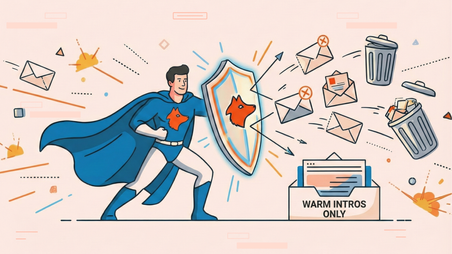Can AI Predict If Your Cold Email Will Work? Yes And Here’s The Exact Prompt

If you’ve ever written a cold email and hit “send” with your fingers crossed, you’re not alone. But what if you could get feedback from your leads before it leaves your inbox?
Thanks to ChatGPT, a prompt, and this blog, you can use AI to predict and analyze cold email performance, simulate reactions, and optimize your message - all on your own.
Summary
You can get feedback on your cold emails with AI-generated personas. To do that, all you need to do is paste this prompt into ChatGPT and add your email:
Here’s my email sequence: {paste your emails here}. I want to send this to {describe your audience}. Create ten different synthetic recipients that fit this category, and predict their reactions to receiving these emails in a way that helps me improve my copy and messaging for maximum relevance.
Take the results and:
- Group the feedback: Think themes, such as unclear CTA, lack of trust, or weak subject line, and then improve your copy.
- Test: Send small batches (25–50 people) based on those recipient types and analyze metrics like open rate, reply rate, and positive replies.
Read on to learn more about using ChatGPT to test your cold emails.
Why it’s so hard to know if your email will work
Even the best cold emails are educated guesses. You research, follow best practices, and A/B test. Your first 50-100 leads are often sacrificed to testing copy. It can feel like a lot. Truthfully, until that campaign goes live, you’re in the dark.
The problem is simple: you’re writing for people you’ve never met.
Every ICP contains shades: the busy decision-maker, the skeptical gatekeeper, the open-minded founder, the happy-but-distracted user.
These people all receive your email differently.
Now, instead of guessing how they’ll react, you can simulate their reactions.
How to use AI to test cold emails before you send them
GenAI is fantastic at roleplaying. That’s why we use AI to create personas that provide us with feedback and ideas for rapidly testing our email copy.
Here’s how it works:
- You feed your cold email draft into ChatGPT, which acts as our AI email analyzer, along with a description of your target audience.
- Then you ask the AI to generate 10 realistic personas based on your ideal customers and predict how each one would react to your email.
- You take the feedback and create small tests to learn what messaging works
Here’s the prompt:
Here’s my email sequence: {paste your emails here}. I want to send this to {describe your audience}. Create ten different synthetic recipients that fit this category, and predict their reactions to receiving these emails in a way that helps me improve my copy and messaging for maximum relevance.
Example: 10 synthetic recipients and their reactions
Let’s say you’re targeting founders of small B2B SaaS companies with your outreach. Here’s what a smart cold email feedback prompt returns:
You’re getting feedback from multiple angles, which is great because each persona can surface different blind spots in your copy.
You’re not just improving word choice-you’re redesigning your message to resonate with real behavior patterns.
How to analyze results and improve your email sequence
Start by grouping reactions into themes:
- Too vague
- Irrelevant
- Unclear CTA
- Lack of trust
When you have your buckets of reactions, you can now rewrite your messaging to address each concern. This process can radically improve your sequence’s clarity, personalization, and tone.
But here’s where it gets tactical: don’t just rewrite-test.
Use an email outreach automation tool like Hunter Campaigns to send small batches of emails (25–50 people per test group) that represent each synthetic recipient type. You can vary your copy slightly for each batch depending on which persona you’re optimizing for.
What to measure
Track the following metrics for each version you test:
Open Rate (OR):
- What it tells you: The strength of your subject line and sender name.
- Target: 30-40%+ is a solid benchmark for most cold emails.
- If high but no replies: Your subject line is good, but your message isn’t connecting.
Reply Rate (RR):
- What it tells you: How compelling your body copy and CTA are.
- Target: 3–6% is a healthy range.
- If low: Look at clarity, length, trust signals, and your CTA.
Positive Reply Rate (PRR):
- What it tells you: The quality of interest you’re generating.
- Target: >50% of your replies should be positive (not just “not interested”).
- If low: Your offer might be clear, but not compelling.
Bounce Rate and Spam Flags:
- What they tell you: Deliverability health.
- Target: Keep bounces under 5%. Spam complaints should be 0%
- If high: Your personalization may be too shallow or list quality poor.
What to do with your feedback data
Once you’ve run a few tests to 25-50 people, you can reflect and continue to refine. Here are some ideas of what to do when the data is painting a picture:
- If opens are low across all groups, refine the subject line. Make it more relevant, curiosity-driven, or pain-point aligned.
- If opens are strong but replies are weak, the hook in your message isn’t doing its job. Test a shorter email, a clearer CTA, or more proof (social, numbers, case studies).
- If one persona batch performs far better, ask: what about this message clicked? Can you adapt that clarity or tone across your campaign?
Rinse and repeat. This process turns your outreach into a learning loop.
The more you test, the better your copy becomes-and the less you waste time on underperforming campaigns.
Final thought: feedback is a foundation
Feedback is the basis for any growth, and it's crucial to cold outreach. With this prompt, you've got a new way to shape your A/B testing.
When you test over the course of a month, you'll be ready to send outreach that will earn you replies, not silence, when it counts.
Try synthetic persona testing with this ChatGPT prompt, improve your copy based on reactions, and use small-batch tests to quickly validate what works.
If you found any of this interesting, make sure you give Hunter’s AI Writing Assistant a try. We’re building it precisely to help you create great emails, personal to each of your leads, using your tone of voice - but at scale.









 Send cold emails with Hunter
Send cold emails with Hunter